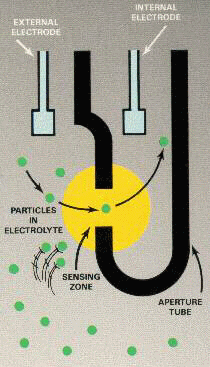




The Coulter Principle

The Coulter Principle has become the accepted "Reference Method" throughout the world for particle size analysis and is the recommended limit test for particulate matter in large-volume parenteral solutions.
The Coulter method of sizing and counting particles is based on measurable changes in electrical impedance produced by nonconductive particles suspended in an electrolyte.
A small opening (aperture) between electrodes is the sensing zone through which suspended particles pass. In the sensing zone each particle displaces its own volume of electrolyte. Volume displaced is measured as a voltage pulse; the height of each pulse being proportional to the volume of the particle.
The quantity of suspension drawn through the aperture is precisely controlled to allow the system to count and size particles for an exact reproducible volume. Several thousand particles per second are individually counted and sized with great accuracy. This method is independent of particle shape, color and density.
Coulter Scientific Instrument Division manufactures four different models of COULTER COUNTER® for Particle Characterization; The Z1, Z2 and Multisizer II e.




© Coulter International Corporation, 1996. All rights reserved. Copyrights and Trademarks